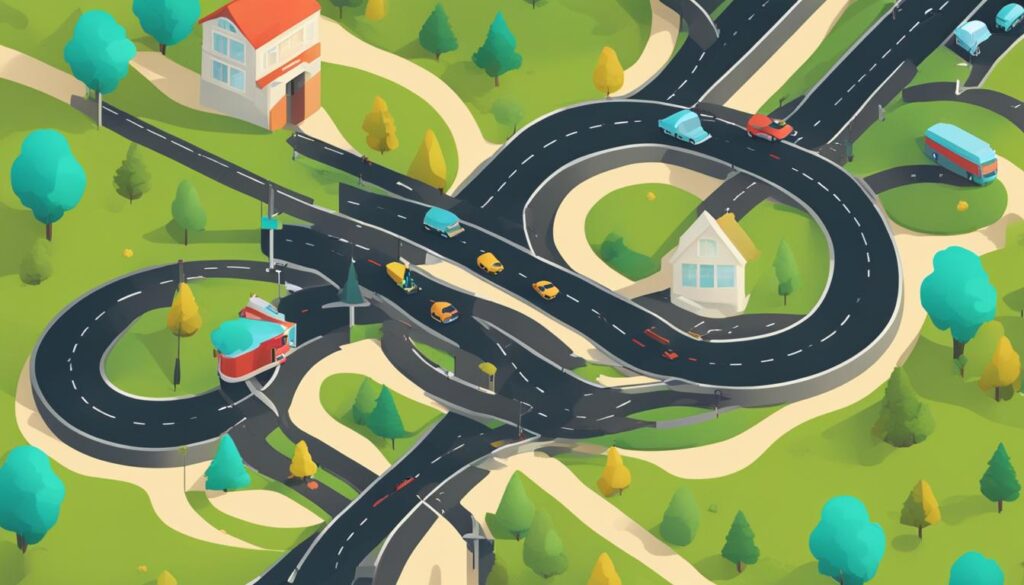JavaScript is a popular programming language used for front-end and back-end web development. If you’re new to JavaScript, it can seem daunting, but don’t worry! This beginner’s guide will introduce you to the basics and essentials of the language, making it easier for you to start learning JavaScript.
From the syntax and data types to functions and control flow, we’ll cover everything you need to know to get started with JavaScript. By the end of this guide, you’ll have a solid foundation in JavaScript programming and be ready to take on more advanced topics.
Key Takeaways
- JavaScript is a popular programming language used for web development
- Learning JavaScript basics is essential for beginner programmers
- JavaScript fundamentals include syntax, data types, functions, and control flow
- By the end of this guide, you’ll have a solid foundation in JavaScript programming
- With the knowledge gained, you’ll be ready to take on more advanced JavaScript topics
Introduction to JavaScript fundamentals
Welcome to the world of JavaScript! If you’re new to programming, JavaScript may seem intimidating at first, but don’t worry – this section will provide an introduction to JavaScript and its basics.
JavaScript is a programming language primarily used for creating dynamic and interactive web pages. It’s an essential skill for any web developer, and learning JavaScript fundamentals will enable you to create engaging and responsive websites.
One of the reasons JavaScript is so popular is that it can be used on both the front-end and back-end of web development. The front-end is what users see and interact with on a website, while the back-end is the server-side code that processes requests and delivers data to the front-end.
JavaScript is a client-side language, meaning it runs in the user’s browser and can manipulate the Document Object Model (DOM) of a webpage. This allows for real-time updates and interactions without needing to reload the page.
Syntax: JavaScript has its own syntax and structure, similar to other programming languages.
Variables: Variables are used for storing data and values in JavaScript.
Data Types: JavaScript has several data types, including strings, numbers, and booleans.
With the basics covered, we can now move on to exploring JavaScript functions in the next section.
JavaScript Fundamental Functions
JavaScript functions are one of the building blocks of JavaScript programming. They allow you to group a set of statements together to perform a specific task. To declare the function, we can use the function keyword.
function functionName(parameters) {
//code block to execute
}
The parameters in the parentheses are optional, and you can pass values to them while calling the function. Functions can also return a value using the return keyword.
function square(num) {
return num * num;
}
Now, if you call the function with square(5), it will return 25. Functions can also be used as variables and passed as arguments to other functions.
Function Scope
Variables declared inside a function are only accessible within that function. This is the function scope. If you declare a variable outside of a function, it is accessible globally and can be accessed by any function.
let globalVar = “I am global”;
function myFunction() {
let localVar = “I am local”;
console.log(globalVar); //output: I am global
console.log(localVar); //output: I am local
}
myFunction();
JavaScript functions are an essential component of JavaScript programming. Learning how to create and use functions will take you one step closer to becoming a proficient JavaScript developer.
JavaScript Control Flow
JavaScript is a powerful programming language that enables developers to write dynamic and interactive web applications. To become proficient in JavaScript programming, you need to have a solid understanding of its control flow.
Control flow refers to the order in which statements are executed in a program. In JavaScript, control flow is determined by the use of conditionals, loops, and switch statements.
Conditionals, also known as if-else statements, enable you to execute a certain block of code if a specific condition is met. For example:
if (x > 10) {
console.log(“x is greater than 10”);
} else {
console.log(“x is less than or equal to 10”);
}
The above code will check if the value of x is greater than 10. If it is, the code inside the conditional block will be executed, otherwise, the code inside the else block will be executed.
Loops allow you to execute a block of code repeatedly for a specified number of times or until a specific condition is met. There are three types of loops in JavaScript – for loop, while loop, and do-while loop.
The for loop is used to execute a block of code a specified number of times. For example:
for (let i = 0; i < 5; i++) {
console.log(“The value of i is: ” + i);
}
The above code will loop through five times, with the value of i incrementing by 1 each time.
The while loop is used to execute a block of code repeatedly until a specific condition is met. For example:
let i = 0;
while (i < 5) {
console.log(“The value of i is: ” + i);
i++;
}
The above code will loop through five times, with the value of i incrementing by 1 each time, until the condition i < 5 is no longer true.
The do-while loop is similar to the while loop, but the code block is executed at least once, even if the condition is false. For example:
let i = 0;
do {
console.log(“The value of i is: ” + i);
i++;
} while (i < 5);
The above code will loop through five times, with the value of i incrementing by 1 each time.
The switch statement enables you to execute different blocks of code based on different conditions. For example:
let color = “red”;
switch (color) {
case “red”:
console.log(“The color is red.”);
break;
case “green”:
console.log(“The color is green.”);
break;
default:
console.log(“The color is neither red nor green.”);
}
The above code will check the value of the variable color and execute a different block of code depending on the value.
Understanding control flow in JavaScript is essential for writing efficient and effective code. By mastering the use of conditionals, loops, and switch statements, you can create dynamic and interactive web applications that provide great user experiences.

JavaScript Objects
Objects are one of the most important concepts in JavaScript programming. They allow you to group related data and functions together, making your code more organized and easier to understand. If you’re learning JavaScript basics, it’s essential to have a good grasp of objects.
An object is a collection of properties, which are key-value pairs. The keys are strings, while the values can be any JavaScript data type, such as numbers, strings, or functions. You can create an object using literal notation or constructor notation.
Here’s an example of an object created using literal notation:
// Creating an object using literal notation let car = { make: 'Toyota', model: 'Camry', year: 2020, isRunning: false, start: function() { this.isRunning = true; console.log('The car is now running.'); }, stop: function() { this.isRunning = false; console.log('The car has been stopped.'); } };
In this example, we created an object called “car,” which has four properties: make, model, year, and isRunning. The values of these properties represent the make, model, year, and whether the car is running or not.
The “car” object also has two methods: start and stop. These are functions that can be called on the object to start or stop the car. When you call a method on an object, the “this” keyword refers to the object itself.
Now that you have a basic understanding of JavaScript objects, you can start using them to organize your data and functions more effectively. Stay tuned to learn more about learning JavaScript programming!
JavaScript Arrays
Arrays are an essential component of JavaScript programming. We use it to store a collection of values in a single variable. Learning how to create and manipulate arrays is fundamental to becoming proficient in JavaScript.
In JavaScript, we declare arrays with square brackets ([]). The elements within the array are separated by commas. You can add any type of data as an element to an array, including strings, numbers, and even other arrays.
For example:
var myArray = ["apple", 3, true, ["orange", 5]];
This example creates an array with four elements. The first element is a string (“apple”), the second is a number (3), the third is a boolean value (true), and the fourth is another array ([“orange”, 5]).
Accessing elements within the array is done through index numbers. Index numbers start at 0 in JavaScript. Therefore, the first element in an array is at index position 0, the second element is at index position 1, and so on.
You can access a specific element within an array by referring to its index number in square brackets. For example:
var myArray = ["apple", "banana", "cherry"];
console.log(myArray[1]); // Output: "banana"
This code declares an array with three string elements. The console.log() statement logs the element at index position 1, which is “banana”.
Manipulating arrays involves adding or removing elements. You can add elements to an array using various methods, including:
push(): adds an element to the end of the array.unshift(): adds an element to the beginning of the array.splice(): adds or removes elements from anywhere within the array.
For example:
var myArray = ["apple", "banana", "cherry"];
myArray.push("date");
console.log(myArray); // Output: ["apple", "banana", "cherry", "date"]
This code adds the string “date” to the end of the array using the push() method.
We can remove elements from an array using methods like:
pop(): removes the last element from the array.shift(): removes the first element from the array.splice(): adds or removes elements from anywhere within the array.
For example:
var myArray = ["apple", "banana", "cherry"];
myArray.pop();
console.log(myArray); // Output: ["apple", "banana"]
This code removes the last element from the array using the pop() method, leaving the array with two elements (“apple” and “banana”).
Finally, JavaScript offers a wide range of array manipulation functions that can assist in sorting, searching and filtering arrays. By the mastery of JavaScript essentials, you can unleash the power of arrays and use them to create robust and dynamic code.
JavaScript DOM Manipulation
JavaScript allows you to manipulate the Document Object Model (DOM), which represents the structure of a web page. With DOM manipulation, you can modify HTML elements, such as changing the text content or the style of an element. This is a powerful tool for creating dynamic and interactive web pages.
One common use of DOM manipulation is to handle events, such as clicking on a button or hovering over an element. You can use JavaScript to attach event listeners to HTML elements and define what actions should be taken when the event is triggered.
Tip: When selecting HTML elements for DOM manipulation, it’s important to choose the right method. For example, you can use
document.getElementById()to select an element by its ID ordocument.querySelectorAll()to select multiple elements based on a CSS selector.
Another technique in DOM manipulation is to create new HTML elements dynamically using JavaScript. This can be useful for adding content to a page without manually editing the HTML code.
Note: When using DOM manipulation, be mindful of the performance impact on your web page. Large-scale modifications or frequent updates can slow down the page’s loading speed and responsiveness.
In summary, JavaScript DOM manipulation is a key part of web development that enables you to create dynamic and interactive web pages. By learning the basics of DOM manipulation, you can enhance your JavaScript programming skills and create engaging user experiences.
JavaScript Error Handling
JavaScript programming can be challenging, and errors are inevitable. Error handling is an essential skill for every JavaScript developer to ensure that your code runs as expected and gracefully handles unexpected scenarios.
One way to handle errors is by using try-catch blocks. The try block contains the code that might generate an error, and the catch block contains the code to handle the error. Using catch blocks, you can provide meaningful error messages to the user, preventing your application from crashing.
“Debugging is like being a detective in a crime movie where you’re also the murderer.”
Another approach to handle errors is by throwing custom errors. You can use the throw keyword to trigger an error manually, indicating that something went wrong. Custom errors are helpful when you need to handle specific types of errors in your code, making it easier to debug and maintain.
Remember to always test your code thoroughly and try to anticipate potential errors. Understanding error handling is an essential part of learning JavaScript, and it will save you countless hours of debugging in the future.
The Importance of Error Handling
Error handling is crucial when developing JavaScript applications. Even minor errors can cause your code to malfunction, leading to unexpected and often frustrating results for your users.
By handling errors gracefully, you can improve the user experience and prevent your application from crashing. Proper error handling can also make your code more maintainable, allowing other developers to understand and debug your code with ease.
Investing time in learning error handling is an investment in your future as a skilled JavaScript developer.
JavaScript Libraries and Frameworks
If you’re looking to boost your productivity and take your JavaScript programming skills to the next level, using JavaScript libraries and frameworks can be a game-changer. These tools provide pre-written code that simplifies complex programming tasks, allowing you to focus on creating unique, high-quality applications.
JavaScript libraries offer pre-built functions and methods that can be easily integrated into your code. One popular library is jQuery, which simplifies DOM manipulation and event handling. Another is Bootstrap, which provides a collection of customizable UI components and styles.
JavaScript frameworks, on the other hand, provide a more structured approach to building applications. They offer a complete set of tools and patterns for developing web applications, including data binding, routing, and state management. Some of the most popular frameworks include React, Angular, and Vue.js.
Whether you choose to use a library or a framework, incorporating these tools into your workflow can significantly reduce development time and improve the quality of your code. Use them wisely and watch your productivity skyrocket!
JavaScript Tools and Resources
Coding in JavaScript requires the right tools to help you code more efficiently and effectively. Here are some of the best JavaScript tools and resources available:
Code Editors
A code editor is an essential tool for any JavaScript developer. These editors provide a suite of features that enable you to write, debug, and deploy your JavaScript code. Popular code editors include:
- Visual Studio Code: A free code editor developed by Microsoft and available for Windows, MacOS, and Linux.
- Sublime Text: A lightweight and versatile code editor available for Windows, MacOS, and Linux.
- Atom: A customizable and open-source code editor developed by GitHub.
Package Managers
Package managers are tools that help you manage and install external libraries and dependencies in your JavaScript projects. Some popular JavaScript package managers are:
- npm: A default package manager for Node.js that allows you to download and manage packages for your JavaScript projects.
- yarn: A package manager from Facebook that aims to improve on the performance and user experience of npm.
Online Tutorials and Documentation
There are many online tutorials and documentation available to help you learn JavaScript and solve problems in your code. Some popular resources are:
- MDN Web Docs: A comprehensive resource maintained by Mozilla that provides documentation and tutorials on JavaScript and web development.
- W3Schools: A popular website that offers tutorials and exercises on JavaScript and other web development technologies.
- Stack Overflow: A Q&A community forum for developers to help each other with coding problems.
Tip: When searching for solutions to coding problems, be sure to read the documentation and check multiple sources for accurate information.
JavaScript Libraries
JavaScript libraries are pre-written collections of reusable code that can help you save time and effort. Some popular JavaScript libraries are:
- jQuery: A fast, small, and feature-rich JavaScript library for DOM manipulation and event handling.
- Lodash: A utility library that provides many helper functions for JavaScript development.
JavaScript Frameworks
JavaScript frameworks are pre-written collections of code that provide a structure for building web applications. Some popular JavaScript frameworks are:
- React: A JavaScript library for building user interfaces, developed by Facebook.
- Angular: A web application framework developed by Google.
Using these JavaScript tools and resources can help you become a more efficient and productive developer. By leveraging these resources, you can write cleaner, more organized, and more maintainable code.

Conclusion
Congratulations on completing this beginner’s guide to JavaScript fundamentals! You now have a strong understanding of the basics of JavaScript programming, making you ready to start your journey as a skilled JavaScript developer.
Remember to continue practicing and building projects to further enhance your skills. With JavaScript, the possibilities are endless, and the more you learn, the more exciting projects you can create.
Whether you’re building a simple web application or a complex web page, JavaScript is a crucial element in modern web development. As you progress in your JavaScript journey, don’t forget to refer back to this guide as a handy reference.
Keep Learning and Growing with JavaScript
The world of JavaScript programming is constantly evolving, and it’s essential to keep up with the latest trends and updates. There are many resources available online to continue your learning journey, from online courses and tutorials to communities and forums.
Some popular websites and resources for learning and growing as a JavaScript developer include W3Schools, MDN Web Docs, Codecademy, and Stack Overflow. These resources can help you stay up-to-date with the latest JavaScript programming techniques and best practices.
Thank you for choosing this guide as your introduction to learning JavaScript. We hope you found it helpful and informative. Happy coding!
FAQ
What is JavaScript?
JavaScript is a programming language commonly used for web development. It allows you to add interactivity and dynamic elements to websites.
Do I need any prior programming knowledge to learn JavaScript?
No, you don’t need any prior programming knowledge to learn JavaScript. It is considered beginner-friendly and can be a great first programming language to learn.
How do I start learning JavaScript?
To start learning JavaScript, you can refer to online tutorials, enroll in courses, or read books specifically designed for beginners. Practice coding and building projects to reinforce your learning.
Can JavaScript be used for both client-side and server-side development?
Yes, JavaScript can be used for both client-side and server-side development. On the client-side, it runs in the web browser, while on the server-side, it can be executed using platforms like Node.js.
Are there any frameworks or libraries associated with JavaScript?
Yes, there are several popular frameworks and libraries associated with JavaScript, such as React, Angular, and Vue.js. These tools can help streamline the development process and provide additional functionality.
How can I debug JavaScript code?
JavaScript provides built-in tools for debugging, such as console.log statements and browser developer tools. You can use these tools to track down and fix issues in your code.
Is JavaScript the same as Java?
No, JavaScript and Java are two different programming languages with distinct syntax and use cases. Although they share a similar name, they are unrelated.
Can I use JavaScript to create mobile applications?
Yes, you can use JavaScript to create mobile applications using frameworks like React Native. These frameworks allow you to write code once and deploy it on multiple platforms.
Are there any job opportunities for JavaScript developers?
Yes, there is a high demand for JavaScript developers in the industry. With JavaScript being widely used for web development, there are ample job opportunities available.
Is JavaScript constantly evolving?
Yes, JavaScript is a constantly evolving language. New features and updates are regularly introduced to enhance its capabilities and address the changing needs of web development.



